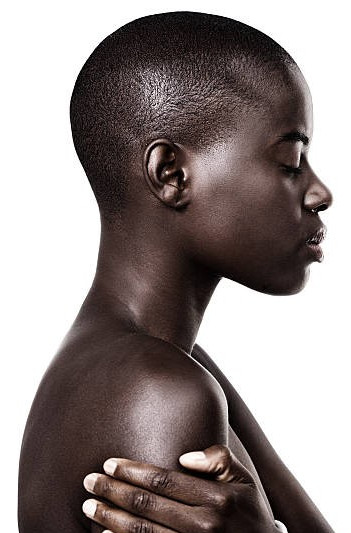AN-La mélanine
Melanin

Melanin is a complex type of pigment that, in humans, is responsible for the pigmentation of our hair, skin and eyes.
Although melanin is generally considered to be a single pigment, there are two types of melanin that contribute to pigmentation.
- Eumelanin: this pigment is associated with dark tones, such as brown and black.
- Pheomelanin: this pigment is associated with alternating hues, such as red and yellow.
A third type of melanin, called neuromelanin, exists in the human brain and gives pigment to structures in this area.
Melanin production begins in large cells called melanocytes, which can be found throughout the body. These melanocytes are responsible for the production of organelles called melanosomes.
Melanosomes are the site of manufacture of eumelanin and pheomelanin, which are then distributed to various cells, such as keratinocytes (skin cells).
Natural melanin levels are mainly determined by genetics and generally determine hair, skin and eye colour. However, there are other factors that can influence melanin production, such as :
- UV light exposure
- inflammation
- hormons
- age
- skin pigmentation disorders
While it is true that melanin production in the skin can be increased by tanning, it is important to remember the biological function of melanin and why tanning can be dangerous.
During sun exposure, the sun’s harmful UV rays penetrate the skin and begin to damage the DNA of the skin cells.
In response to this cellular damage, the body tries to produce more melanin to protect the cells. This increase in melanin production is what creates the “tan” on the skin.
However, once the skin starts to tan, it indicates that cellular damage has already occurred.
The amount of melanin produced by tanning – whether from the sun or from other UV exposure – is not enough to protect skin cells from further damage. Over time, this cellular damage can potentially lead to skin cancer.
In addition to providing pigmentation in humans and animals, melanin also plays an important biological role in protecting against sun damage.
Melanin helps protect the cells of the epidermis, or outer layer of the skin, from UV radiation. This protection extends to all forms of UV light (UVC, UVB and UVA) as well as blue light. It does this by absorbing UV light before it can damage the sensitive DNA of the skin cells.
Melanin also demonstrates antioxidant activity by scavenging reactive oxygen species produced by UV light damage. Without the intervention of protective compounds such as antioxidants, these species contribute to oxidative stress, which causes significant cellular damage.
Despite the many variations in human skin, hair and eye colour, almost all humans have approximately the same number of melanocytes.
However, darker skinned people have more numerous, larger and more pigmented melanosomes than lighter skinned people.
Interestingly, these melanosomes also appear to display specific distribution patterns based on skin colour. These differences all contribute to the wide variety of skin colours and tones in humans.
Genetics usually determines the amount of melanin in your hair, skin and eyes. But two conditions can occur when your body lacks melanin:
Vitiligo is an autoimmune disease that occurs when the body does not produce enough melanocytes. This causes a lack of pigment that can appear as white patches on the skin or hair. Vitiligo affects between 1 and 2% of people worldwide.
Albinism is a rare genetic disease that occurs when the body does not produce enough melanin. This can occur due to a reduced number of melanocytes or a reduced production of melanin by the melanosomes. There are different types of albinism, but most cause a moderate to severe lack of pigment in the skin, hair and eyes.
